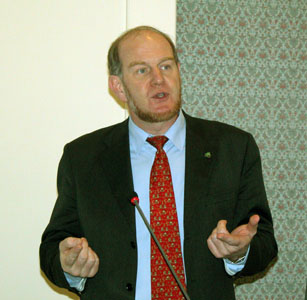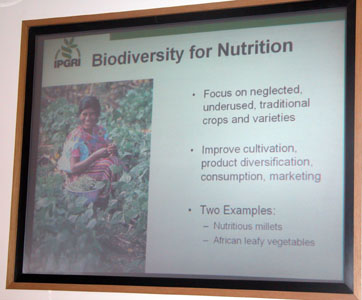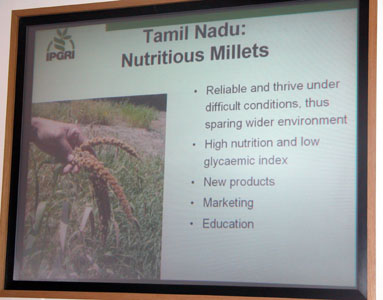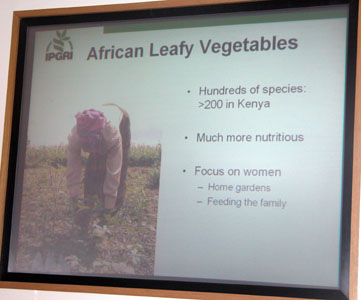procedures and mechanisms for compliance:
|
|
|
|
|
|
|

|

|
|
The Netherlands, on behalf of the European Community and its Member States (EU),
suggested convening the working group prior to the first session of the Governing Body and requesting the Secretariat to prepare a draft with options to facilitate its
discussions. Above photo: René Lefeber and Hans
Hoogeven (The Netherlands, on behalf of the EU)
|
Clive
Stannard, Secretariat, introduced a compilation and analysis of governments’ views on compliance with the Treaty.
|
|
|
|
|
|
|
|

|

|
|
BRAZIL
added that the compliance mechanism should be positive,
cooperative, facilitative, voluntary, transparent, flexible
and non-controversial, assisting Parties in implementation and
aiming to oversee that the scope of the Treaty is not
disrespected. Above photo: Maria Angelica Ikeda
(Brazil)
|
Colombia,
on behalf of G-77/CHINA, stressed the need for an inter-sessional
working group meeting on rules of procedure and financial
rules. Above photo L-R: Juan Carlos Sanchez Franco and Ricardo Carrasco
Torres (Colombia)
|
|
Work
programme and budget of the governing body:
|
|
|
|

|

|
|
Chair
Bryan Harvey (Canada) invited comments on the work
programme and budget for the Governing Body.
|
SPAIN
reiterated its offer to host the first meeting of the
Governing Body. Above photo: Francisco Martínez Arroyo
(Spain)
|
|
|
|

|

|
|
ERITREA
requested clarification on participation at the first meeting
of countries that are not Parties yet, having ratified the
Treaty less than 90 days before the first session of the
Governing Body. Above photo: Yohannes Tensue (Eritrea)
|
SWITZERLAND prioritized
implementation of ITPGR Article 6 (Sustainable Use of Genetic
Resoures). Above photo:
Geert Kleijer (Switzerland)
|
|
Work
programme and budget of the interim committee:
|
|
|

|

|
|
The US prioritized the completion of the standard MTA by the
Interim Committee, and offered to host the inter-sessional
contact group in early 2005. Above photo: David Hegwood (US)
|
BANGLADESH
requested a timetable for inter-sessional activities and means
for the implementation of the work programme. Above photo: Abdur
Razzaque (Bangladesh)
|
|
|
|

|

|
|
SUDAN requested special budgetary allocations for
implementation activities in developing countries. Above
photo:
Adam Mohamed Abu Baker
(Sudan)
|
CANADA
suggested building on CGRFA-10 decisions regarding the GPA and
Facilitation Mechanism in the review of financial requirements
for Treaty implementation. Above photo: Campbell Davidson
(Canada)
|
|
agreements
between the governing body and the iarcs:
|
|
 |
 |
|
A
CGIAR
representative highlighted: the perpetual duration of the
agreement; amendments by parties by mutual agreement; and
periodic consultations with the Secretariat on implementation
of the agreement. Above photo L-R: N. Delegates from
CGIAR-IPGRI with Ruaraidh Sackville Hamilton, Gerald
Moore, Carey Fowler and Sami Gaiji.
|
JAPAN suggested more specific references to rights and
obligations of IARCs and the Governing Body. Hideo Inomata
(Japan)
|
|
|
ENB ITPGR SNAPSHOTS:
|
|
|

|

|

|
Above photos L-R: The
Secretariat's Clive Stannard and Martin Smith (CGRFA)
in discussion with Kristianne Herrmann (Australia); June
Blalock (US) in a conversation with Carey Fowler and
N. Ruaraidh Sackville Hamilton (IPGRI); Ambassador
Flavio M. Perry (Brazil) in discussion with Jose
Esquinas Alcazar, Secretary of the CGRFA. |
|
|
|
|
|
Above photos L-R: Sahr Ngoba
Fomba (Sierra Leone); Andrée Sontot (France), Anders
Christiansen (Denmark) Hans Hoogeveen and Dirk de Jong
(The Netherlands); Samson Syankwilimba (Zambia), Shadrack
Sariri Mlambo (Zimbabwe) and Godfrey Mwila (Zambia)
|
|
|
|
|
Above photos L-R: Margaret
Mohapi (South Africa); Tuula Pehu (Finland); and Kristianne
Herrmann (Australia)
|
|
|
|
Above photo L-R: Modeste Mamingi
Mfundu (Democratic Republic of the Congo); Abebe Demissie
and Fassil Kebebew (Ethiopia); Hans Hoogeveen (The
Netherlands) and Govinda Prasad Pandey (Nepal)
|
SIDE EVENT:
|
|
|
|
Emile
Frison, Director General of the International Plant Genetic Resources
(IPGRI) (left) presented IPGRI's new strategic direction through its
"Diversity for Well-being." He showed delegates
on-going agricultural diversity projects that promote social, economic
and environmental benefits, two examples mentioned are Tamil Nadu:
Nutrious Millets and African Leafy Vegetables. He also noted the
IPGRI's membership to the Future Harvest Alliance, a global grouping
of research centers focused on rural development and poverty
alleviation through better and sustainable use of agriculture. For
further information on IPGRI and its involvement with Future Harvest
please visit their websites at www.ipgri.cgiar.org
and www.futureharvest.org .
|
|
|
|
|
|
|
|
|
|
|
|
|

































